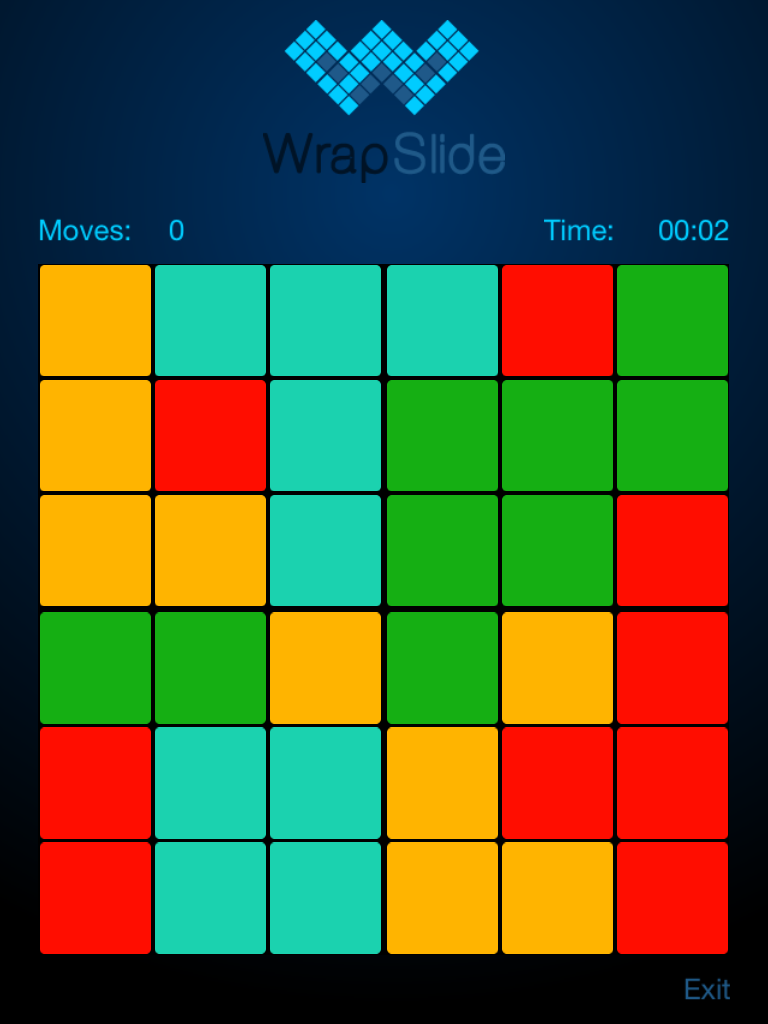Developed by Alewyn Burger, a researcher at Stellenbosch University (South Africa), it might look like just another toroidal sliding block puzzle. But looks, in this case, are very deceiving. The movement mechanics are different from the usual ones, and produce a very challenging puzzle.
Usually, in toroidal sliding block puzzles you slide a single row or column at a time. This makes them pretty easy, because it gives a lot of freedom of movement. WrapSlide is different in a simple but clever way: the lines in each half of the board (both horizontally and vertically) all slide together. This is a significant constraint, and I can say that the experience I had when confronted with a scrambled puzzle was remarkably similar to the first time I played with a Rubik's cube.
Fixing one quadrant is rather simple, fixing a second one is trickier but still doable without advanced techniques. Doing the third quadrant without breaking up what you did before, however, is difficult, and I haven't managed to do it yet. Every time I try to use a commutator, I forget the moves I made and mess up everything.
Helpfully, the game provides different levels of difficulty to let you practice gradually. The number of colors can be 2, 3, or 4, and the size can be 4x4, 6x6, or 8x8. My suggestion is to initially practice with 3 colors.
In all modes, the game will scramble the board for you and your task is to put it back together. Note that you just need to make each quadrant the same color, it doesn't matter which one.
Additionally, for each board size there is one predefined puzzle, which you can use to compete on the leaderboards. I like that the predefined puzzles cover all settings for the number of colors, so the 4x4 one has 4 colors:
6x6 has 2 colors:
and 8x8 has 3 colors:
The latter two are not difficult to solve, but the first one currently has me stumped. I always seem to have one block out of place. I even wondered if there was some parity issue making it unsolvable, but that wouldn't be possible because it has been proven (in Dutch) that every configuration is reachable.
The author has done some research on the God's algorithm for this game. For the 4x4 size with 4 colors, every position can be reached in 12 moves or less.
For the 6x6 size, the lower bound is 20, while the upper bound is 31. For comparison, a few years ago it was proven that God's number for the Rubik's Cube is 20.
As you might have guessed, the premixed 4x4 puzzle needs all of those 12 moves. 12 moves don't seem many, but it's unlikely that a human can manage to find them. As far as I'm concerned, I'd be happy to just solve the puzzle, no matter in how many moves :-)
The premixed 6x6 puzzle needs 12 moves as well. I'm not sure about the 8x8 one.
The user interface is pretty hard to use. On the main menu there are two knobs at the bottom of the screen. Turning the left one you change the size, turning the right one you change the number of colors or select the premixed puzzle. Frankly I would have preferred some more standard buttons.
The user interface during the game is ok but could be improved. Touches are often ignored for a short while after making a move, which makes the controls feel unresponsive. Also, it would be nice to have multitouch support, so that you could use two fingers to slide all lines at once.
If you like rearrangement puzzles, definitely try this one. It has a rare elegance and simplicity, and yet it's uncompromisingly difficult.
Summary
| Nontrivialness | ★★★★★ |
| Logical Reasoning | ★★★★★ |
| User Interface | ★★☆☆☆ |
| Presentation | ★★☆☆☆ |
| Loading Time | ★★★★★ |
| Saves Partial Progress | ✘ |
| Status Bar | ✘ |
©2014 Nicola Salmoria. Unauthorized use and/or duplication without express and written permission is strictly prohibited. Excerpts and links may be used, provided that full and clear credit is given to Nicola Salmoria and nontrivialgames.blogspot.com with appropriate and specific direction to the original content.






